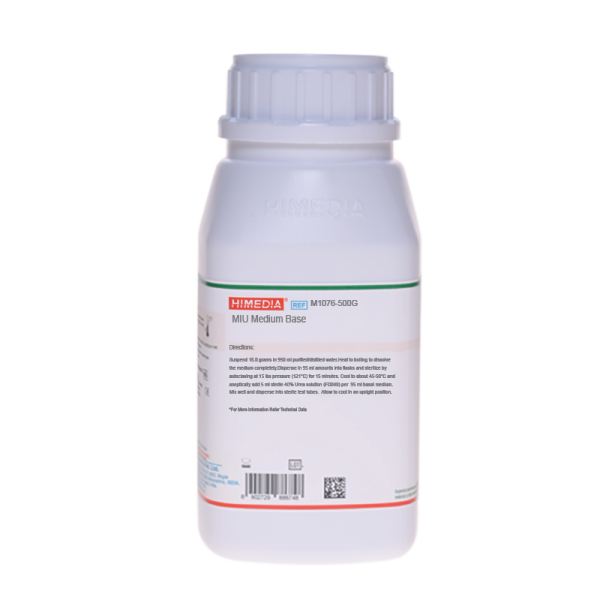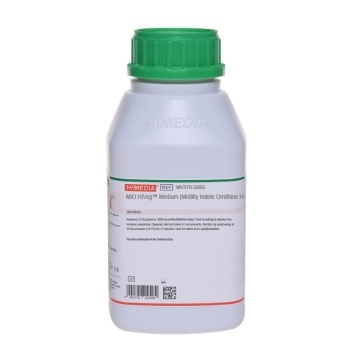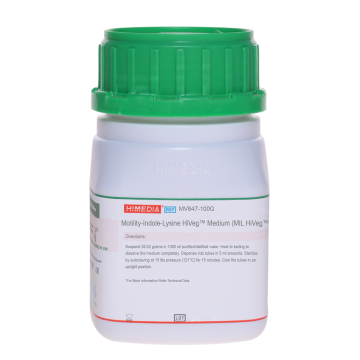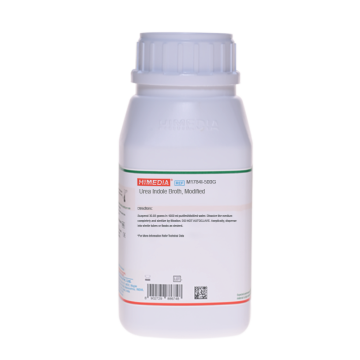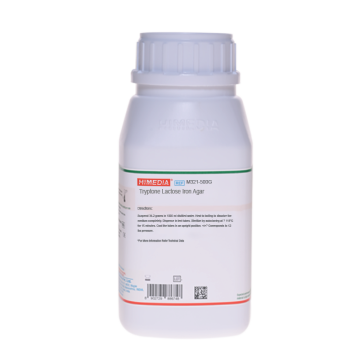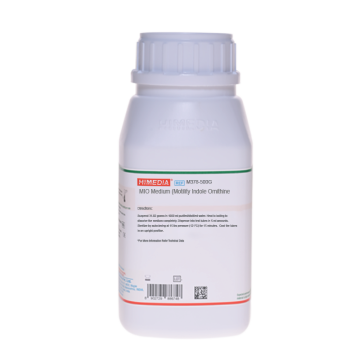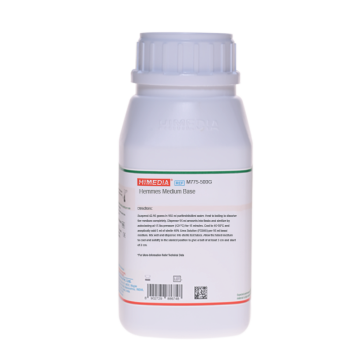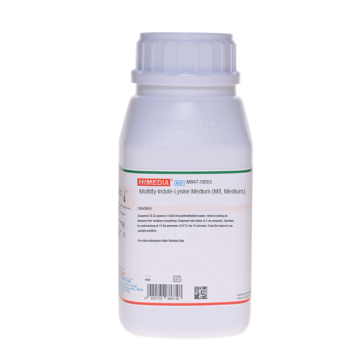 Your enquiry has been submitted
Your enquiry has been submitted
MIU Medium Base
Intended Use
Recommended for detection of motility, urease and indole production.
Composition
| Ingredients | Gms / Litre |
|---|---|
| Tryptone | 10.000 |
| Dextrose (Glucose) | 1.000 |
| Sodium chloride | 5.000 |
| Phenol red | 0.010 |
| Agar | 2.000 |
Final pH (at 25°C): 6.8±0.2
Formula adjusted, standardized to suit performance parameters
Directions
Suspend 18 grams in 950 ml purified / distilled water. Heat to boiling to dissolve the medium completely. Dispense in 95 ml amounts into flasks and sterilize by autoclaving at 15 lbs pressure (121°C) for 15 minutes. Cool to about 50-55°C and add aseptically 5 ml sterile 40% Urea solution (FD048) per 95 ml basal medium. Mix well and dispense into sterile test tubes. Allow to cool in an upright position.
Principle And Interpretation
MIU Medium Base is formulated to detect motility, urease and indole production in single tube. Tryptone provide amino acids and other nitrogenous substances. Sodium chloride maintains osmotic equilibrium. Dextrose is fermentable carbohydrate. Phenol red is the pH indicator which turns pink- red in alkaline conditions. The test cultures are stab-inoculated.
Motility and urease reactions are read before testing Indole production. Motile organisms show either diffused growth or turbidity extending away from stab inoculation line while nonmotile organisms grow along the stabline. Organisms that utilize urea, produce ammonia which makes the medium alkaline, showing pink-red colour by change in the phenol red indicator (5). Indole is produced from tryptophan present in tryptone (1,4). The indole produced combines with the aldehyde present in the Kovac's reagent to form a red complex.
Type of specimen
Isolated Microorganism
Specimen Collection and Handling
For samples follow appropriate techniques for handling specimens as per established guidelines (2,3).
After use, contaminated materials must be sterilized by autoclaving before discarding.
Warning and Precautions
Read the label before opening the container. Wear protective gloves/protective clothing/eye protection/ face protection. Follow good microbiological lab practices while handling specimens and culture. Standard precautions as per established guidelines should be followed while handling specimens. Safety guidelines may be referred in individual safety data sheets.
Limitations
- Due to nutritional variations, some strains may show poor growth.
Performance and Evaluation
Performance of the medium is expected when used as per the direction on the label within the expiry period when stored at recommended temperature.
Quality Control
Appearance: Light orange to light pink coloured homogeneous free flowing powder
Gelling: Semisolid, comparable with 0.2% Agar gel.
Colour and Clarity of prepared medium: Yellowish orange coloured clear to slightly opalescent gel is obtained in tubes as butts afteraddition of urea solution.
Reaction: Reaction of basal medium (1.8 gm suspended in 95 ml distilled water) at 25°C. pH: 6.8±0.2
pH: 6.60-7.00
Cultural Response
Cultural characteristics observed with added 40% Urea solution (FD048) after an incubation at 35-37°C for 18 - 24 hours.
| Organism | Growth | Indole | Motility | Urease activity |
|---|---|---|---|---|
| Escherichia coli ATCC 25922 (00013*) | luxuriant | Positive reaction, red ring at the interface of the medium | Positive, growth away from stabline causing turbidity | Negative reaction, no change |
| Klebsiella pneumoniae ATCC 13883 (00097*) | luxuriant | Negative reaction no colour development / cloudy ring | Negative growth along the stabline,surrounding medium remains clear | Weakly positive |
| Proteus mirabilis ATCC 25933 | luxuriant | Negative reaction no colour development / cloudy ring | Positive, growth away from stabline causing turbidity | Positive reaction, cerise colour |
| Proteus vulgaris ATCC 13315 | luxuriant | Positive reaction, red ring at the interface of the medium | Positive, growth away from stabline causing turbidity | Positive reaction, cerise colour |
| Salmonella Typhimurium ATCC 14028 (00031*) | luxuriant | Negative reaction no colour development / cloudy ring | Positive, growth away from stabline causing turbidity | Negative reaction,no change |
Key: *Corresponding WDCM numbers.
Storage and Shelf Life
Store between 10-30°C in a tightly closed container and the prepared medium at 2 - 8°C. Use before expiry date on the label. On opening, product should be properly stored dry, after tightly capping the bottle in order to prevent lump formation due to the hygroscopic nature of the product. Improper storage of the product may lead to lump formation. Store in dry ventilated area protected from extremes of temperature and sources of ignition Seal the container tightly after use.
Product performance is best if used within stated expiry period.
Disposal
User must ensure safe disposal by autoclaving and/or incineration of used or unusable preparations of this product. Follow established laboratory procedures in disposing of infectious materials and material that comes into contact with sample must be decontaminated and disposed of in accordance with current laboratory techniques (2,3).
References
- Ewing (1986) Edwards and Ewings 'Identification of Enterobacteriaceae', 4th ed. Elsevier Science Publishing Co., Inc., New York.
- Isenberg, H.D. Clinical Microbiology Procedures Handbook 2nd Edition.
- Jorgensen, J.H., Pfaller, M.A., Carroll, K.C., Funke, G., Landry, M.L., Richter, S.S and Warnock., D.W. (2015) Manual of Clinical Microbiology, 11th Edition. Vol. 1.
- McFaddin J.F. (1985) Media for Isolation-Cultivation-Identification-Maintenance of Medical Bacteria, Vol. 1, Williams and Wilkins, Baltimore
- Rustigian and Stuart (1941) Proc. Soc. Exp. Biol. Med., 47:108.
| Product Name | MIU Medium Base |
|---|---|
| SKU | M1076 |
| Product Type | Regular |
| Physical Form | Powder |
| Origin | Animal |
| Packaging type | HDPE |
| References | 1. Rustigian and Stuart (1941) Proc. Soc. Exp. Biol. Med., 47:108. |
| Customized Product Available | No |



